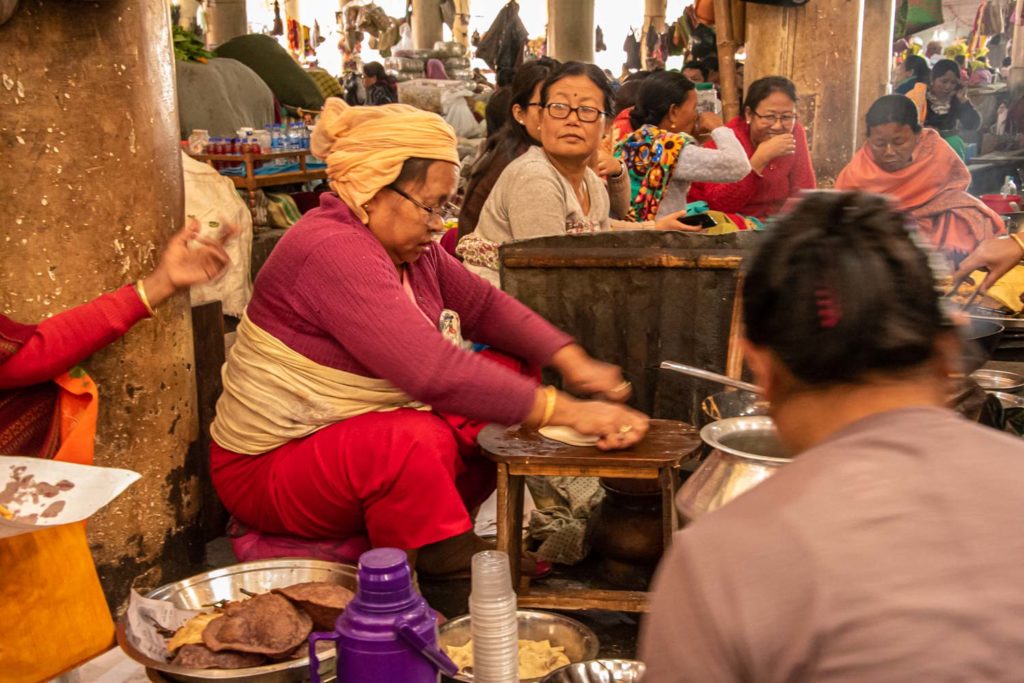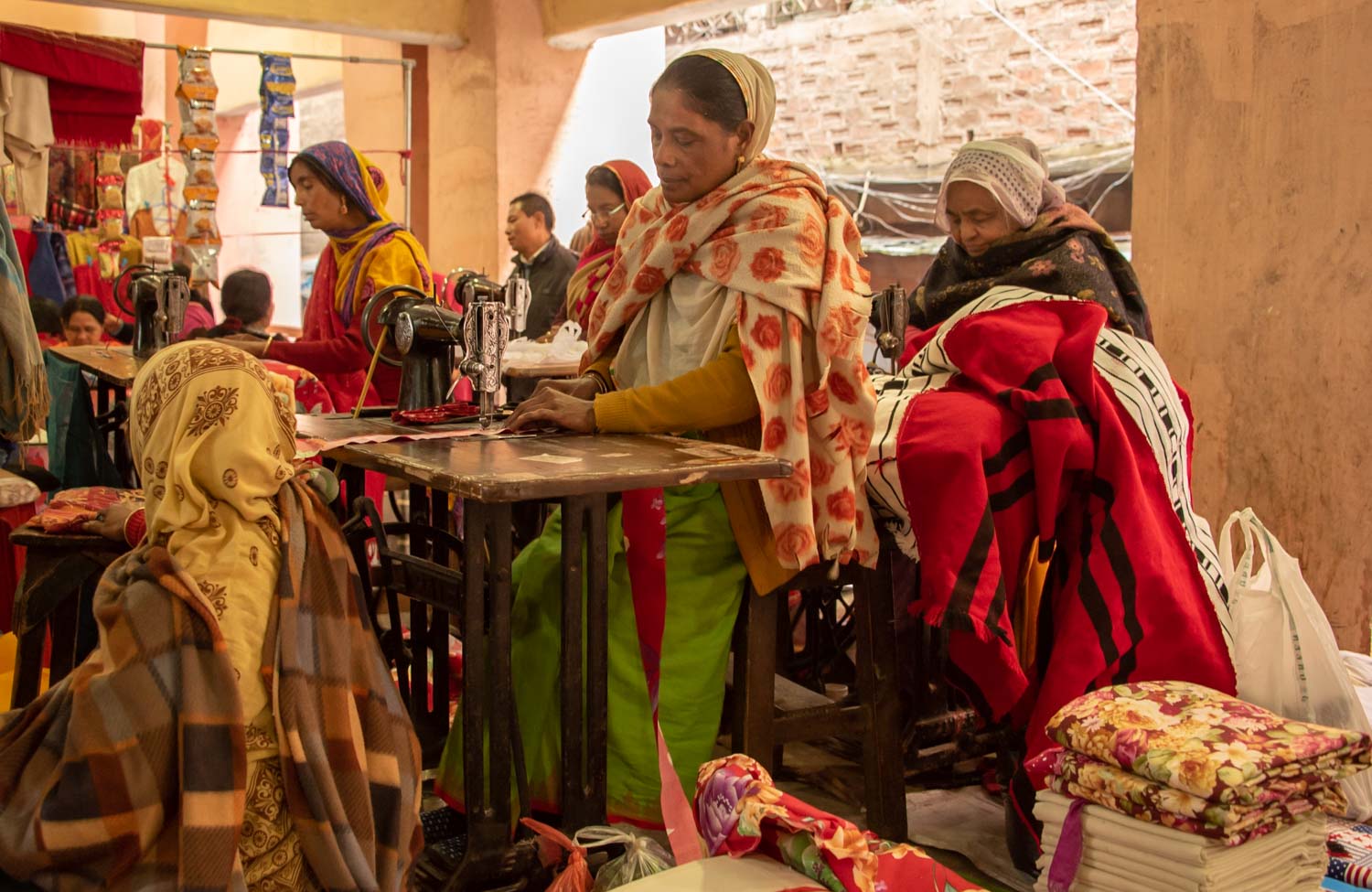American pop star Beyoncé topped the charts a decade ago with her smash, Run the World (Girls). And women absolutely run the colorful, dynamic Women’s Market in Imphal, capital city of northeast India’s state of Manipur. With the market’s aliases—Ima Keithel, Mothers’ Market, Market of Matriarchs, and Queen of Markets—this 500-year-old establishment operates under the direction of a union of women.
No men allowed.
Our guide Rajiv Verma, principal of Northeast Explorers, brings us to Asia’s largest female-owned and operated market on this first day of a two-week adventure to India’s remote northeast states. The emporium fills three buildings on either side of a broad boulevard with an elevated highway down its middle.
One building houses sellers of vegetables, flowers, fruit, fish, and household goods and kitchen utensils. Across the street, shop owners in the other two buildings display piles of brightly colored and patterned handmade Manipuri textiles, handicrafts, clothing, toys, and bamboo products. Here, about a dozen women sit at sewing machines stitching fabric and making stenciled cut-outs from a translucent white material for Hindu prayer flags. Scattered among the stalls, women make chapatis (Indian flatbreads like tortillas), soup, and tea for each other.
Manipur ranks as one of India’s smallest and least populated states. For centuries, its geographic location made it a gateway to Burma, Southeast Asia, China, and Siberia. Agriculture, forestry, and cottage handicrafts comprise Manipuri economy. The thriving success and sheer size of the Women’s Market contributes significantly to the cottage industry economy of the state, making it also a place for socializing and discussing ideas and current events in the community and region.
How did the Market become so influential?
I traced the history to its mid-1500s roots.
Manipur’s king instituted draconian labor laws that sent men to work far away, or to fight in the army, leaving women and children to fend for themselves in villages. To support their families, women created the market, often making handicrafts for sale while tending rice paddies and food gardens. The market flourished for hundreds of years while its influence as an economic generator grew. But the governing British instituted harsh economic and political reforms in the 1890s. Ima Keithel Market languished.
In 1939 the women waged Nupi Lan (Women’s War), against the reforms using protests, rallies, and mass meetings; Manipuri men remained silent. To protest the oppressive economic policies of the British, the women occupied the Presidential building and requested an audience with the local ruling maharaja, who was under the thumb of the British. The Assam Rifles paramilitary police fired on the women, wounding many, but they refused to surrender. The men joined the women at the point and the resistance became a fight for autonomy and independence.
British rulers tried to quell the insurgents by selling the Market’s buildings to foreign investors but the women succeeded in thwarting potential sales. Finally, after India gained independence in 1948, the Market fully recovered and regained its prominence as an economic generator. The spirit of Nupi Lan came to symbolize gender equality and female empowerment, and the Market became a center for the exchange of ideas that affected politics and Manipuri society.
Women run the Market’s operations through a union that extends credit to its members to purchase goods. About 5,000 married women (to be wed is a requirement; some ancient ideas still have standing in the subcontinent) hold licenses to sell and trade goods. Licenses are inheritable, passed down through generations. Many shopkeepers come from faraway villages, and families often depend on the stalls’ sales for family incomes. Every day, these ladies dress in traditional garb––phaneks (sarongs) and innaphis (shawls) and go to work.
Won’t that make a nice lungi?
Today, I can’t seem to get out of the way of hustle and bustle. Hundreds of people crowd the aisles to window-shop, barter, and buy, and friendly voices of the trade fill the market. Proprietors display their wares and chat up potential customers. Some smile at me; others seem to know they probably won’t make a sale to this turista.
Except…when we round one aisle and find a stall with eye-catching hand-woven textiles. The proprietor, a square-faced grandmother with eyes that laugh a lot, wrapped in two shawls over her dress, spreads out every piece we point to. My partner Rick holds up a selection for final approval. The material boasts brilliant diamonds of orange and shades of green, interspersed with black stripes and strands of green thread. The cloth will make a handsome lungi, a traditional skirt-like garment worn by men and women in Asia’s subcontinent, a thank you gift for a friend back home who is watering our house plants. The purchase pleases both seller and buyer.
No men are allowed to own shops or sell, only serve as runners who can help bring goods from vehicles and perform other heavy-duty tasks. As we leave the Market, I do see one man sitting in a stall all by himself. Our guide assures me he’s shop-sitting while the proprietor runs her errands. I imagine he knows who’s in charge here.
If You Go
- Itinerary suggestion–you will be in a unique and remote part of the world. Plan for a week or two to visit Imphal, Loktak Lake, and small towns in Manipur, then head north to the state of tribal Nagaland to Kohima. Try to catch December’s Hornbill Festival where the country’s tribes gather annually to celebrate at Naga Heritage Village in Kohima.
- By air: Direct flights from three domestic terminals to Imphal International Airport: New Delhi, Kolkata, and Guwahati.
- Arrival:
Foreigners arriving by air must register at the Imphal International Airport’s immigration counter upon arrival.
Domestic travelers travelers need to obtain an Inner Line Permit (ILP) to enter Manipur and three other Northeast Indian states, obtainable online. The purpose of the ILP is to protect and respect indigenous tribal cultures in this area. - Recommended: Hire a guide to visit the area’s sites. If Imphal is part of a larger Northeastern states visit, a guide is critical to have in this remote part of India.
Contact Rajiv Verma at hello@northeastexplorers.in. Rajiv is an engaging, intelligent humanist who loves his area of India and knows how to navigate its unusualness. (He’s also a techie geek and website designer, so go figure!) Rajiv will arrange accommodations with hotels and homestays. He made our trip memorable.



